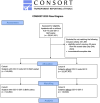Risk Factors Associated With Bell's Palsy: A Real-World Analysis of 281,600 Patients
- PMID: 40838411
- PMCID: PMC12368598
- DOI: 10.1111/ene.70336
Risk Factors Associated With Bell's Palsy: A Real-World Analysis of 281,600 Patients
Abstract
Introduction: Bell's palsy is the most common cause of peripheral facial paralysis, with an annual incidence of 5-50 per 100,000 cases worldwide. Its etiology remains largely unknown, though risk factors such as herpes simplex virus reactivation, diabetes, depression, and pregnancy-related complications have been suggested. Understanding these risk factors is critical for improving diagnosis, prevention, and treatment strategies.
Methods: A retrospective analysis of the TriNetX database included over 25 million patients. Two cohorts of approximately 140,800 patients each, matched for age and sex, were analyzed for associations between BP and herpes simplex virus, diabetes, depression, and pregnancy. Odds ratios (OR) and confidence intervals (CI) were calculated, with p < 0.05 indicating significance.
Results: Herpes simplex virus showed the strongest association with Bell's palsy (OR: 6.49, 95% CI: 5.96-7.05); followed by diabetes (OR: 2.4, CI: 2.36-2.46) and depression (OR: 2.05, CI: 2.0-2.1). Pregnancy was inversely correlated (OR: 0.76, CI: 0.73-0.78).
Conclusion: Herpes simplex virus reactivation appears to be a major risk factor, suggesting a potential role of antiviral therapies in select cases. The associations with diabetes and depression highlight a need for metabolic and mental health evaluations in patients with Bell's palsy. The inverse correlation with pregnancy warrants further investigation into pregnancy-related conditions. These findings emphasize the multifactorial nature of this condition and the importance of individualized approaches to reduce its idiopathic classification.
Keywords: Bell's palsy; depression; herpes; pregnancy; risk factors.
© 2025 The Author(s). European Journal of Neurology published by John Wiley & Sons Ltd on behalf of European Academy of Neurology.
Conflict of interest statement
The authors declare no conflicts of interest.
Figures





Similar articles
-
Antiviral treatment for Bell's palsy (idiopathic facial paralysis).Cochrane Database Syst Rev. 2015 Nov 9;(11):CD001869. doi: 10.1002/14651858.CD001869.pub8. Cochrane Database Syst Rev. 2015. PMID: 26559436
-
Antiviral treatment for Bell's palsy (idiopathic facial paralysis).Cochrane Database Syst Rev. 2015 Jul 1;(7):CD001869. doi: 10.1002/14651858.CD001869.pub6. Cochrane Database Syst Rev. 2015. Update in: Cochrane Database Syst Rev. 2015 Sep 07;(9):CD001869. doi: 10.1002/14651858.CD001869.pub7. Update in: Cochrane Database Syst Rev. 2015 Nov 09;(11):CD001869. doi: 10.1002/14651858.CD001869.pub8. PMID: 26130372 Updated.
-
WITHDRAWN. Antiviral treatment for Bell's palsy (idiopathic facial paralysis).Cochrane Database Syst Rev. 2015 May 4;(5):CD001869. doi: 10.1002/14651858.CD001869.pub5. Cochrane Database Syst Rev. 2015. Update in: Cochrane Database Syst Rev. 2015 Jul 01;(7):CD001869. doi: 10.1002/14651858.CD001869.pub6. PMID: 25938618 Updated.
-
Aciclovir for Bell's palsy (idiopathic facial paralysis).Cochrane Database Syst Rev. 2001;(4):CD001869. doi: 10.1002/14651858.CD001869. Cochrane Database Syst Rev. 2001. Update in: Cochrane Database Syst Rev. 2004;(3):CD001869. doi: 10.1002/14651858.CD001869.pub2. PMID: 11687127 Updated.
-
Aciclovir for Bell's palsy (idiopathic facial paralysis).Cochrane Database Syst Rev. 2001;(2):CD001869. doi: 10.1002/14651858.CD001869. Cochrane Database Syst Rev. 2001. Update in: Cochrane Database Syst Rev. 2001;(4):CD001869. doi: 10.1002/14651858.CD001869. PMID: 11406014 Updated.
References
-
- Tiemstra J. D. and Khatkhate N., “Bell's Palsy: Diagnosis and Management,” American Family Physician 76, no. 7 (2007): 997–1002. - PubMed
MeSH terms
LinkOut - more resources
Full Text Sources
Medical

